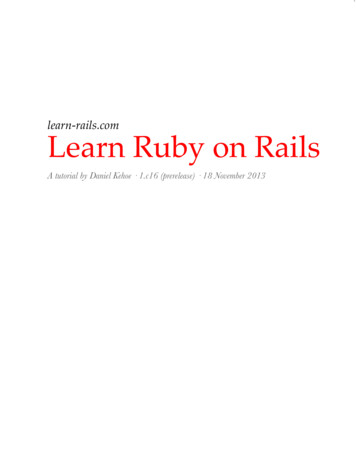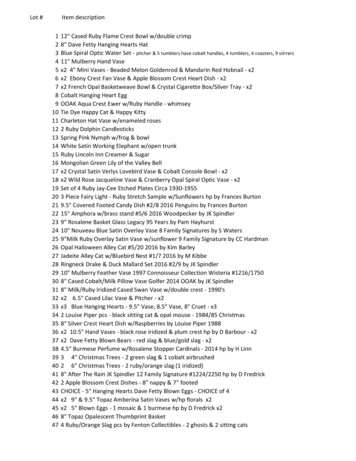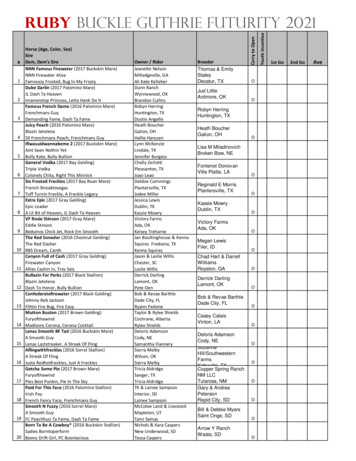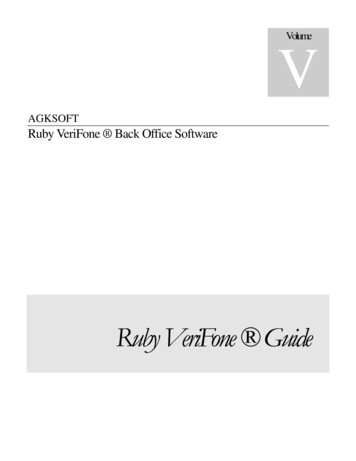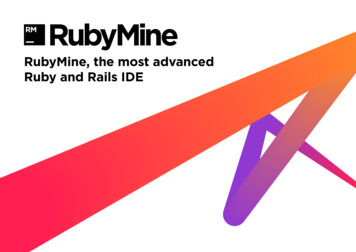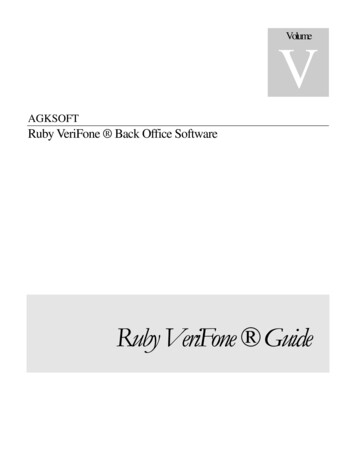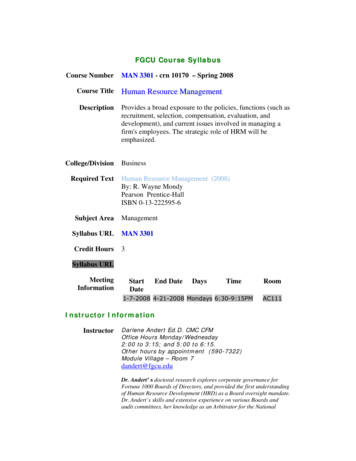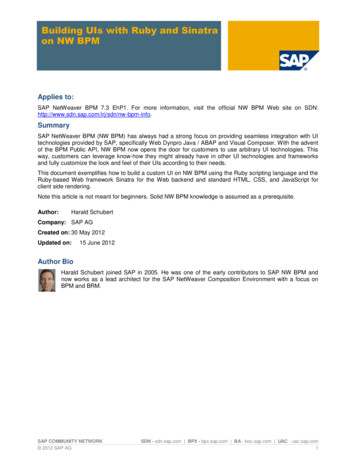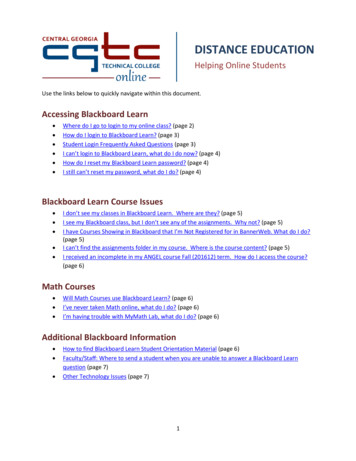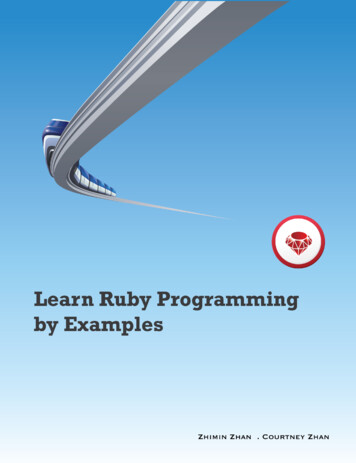
Transcription
Learn Ruby Programming by ExamplesZhimin Zhan and Courtney ZhanThis book is for sale at les-enThis version was published on 2018-09-23This is a Leanpub book. Leanpub empowers authors and publishers with the LeanPublishing process. Lean Publishing is the act of publishing an in-progress ebook usinglightweight tools and many iterations to get reader feedback, pivot until you have the rightbook and build traction once you do. 2014 - 2018 Zhimin Zhan
ContentsPreface . . . . . . . . . . . . . . . . .What is unique about this book?Who should read this book . . .How to read this book . . . . . .Send me feedback . . . . . . . .iiiiiiiviv1. Introduction . . . . . . . . . . . . . . . . . .1.1Ruby on Windows . . . . . . . . . . .1.2Ruby on Mac OS X . . . . . . . . . . .1.3Online Ruby Tutorials . . . . . . . . .1.4Rhythm for Working on the exercises1.5Suggestions on Windows Layouts . .1.6Type of errors . . . . . . . . . . . . . .1.7Interactive Ruby Shell (IRB ) . . . . .11589912152. Printing Shapes . . . . . . . . . . . . . .2.1Print out Triangle . . . . . . . . . .2.2Print out a half diamond . . . . .2.3Print out diamond shape . . . . .2.4Print big diamond, name your size2.5Exercises . . . . . . . . . . . . . . .161620242730Resources . . . . . .Code Editor . . .Ruby Language .Ruby Tutorials .More Exercises .Test AutomationOthers . . . . . .31313131323232.
PrefaceOn December 8, 2013, US President Barack Obama “asked every American to give it a shotto learn to code” (watch it here¹), kicking off the Hour of Code campaign for ComputerScience Education Week 2013. “Learning these skills isn’t just important for your future, it’simportant for our country’s future,” President Obama said.In February 2013, Mark Zuckerberg and Bill Gates and several other big names in IT wantkids to learn code (video²). I particularly like the quote at the beginning of the video:“Everybody in this country should learn how to program a computer because itteaches you how to think.” - Steve JobsYou don’t have to be an American to get the message: coding (aka. programming) is animportant skill for this information age. Besides the importance of programming, the othermessage those VIPs also tried to convey is that “you can do it”.As a programmer and software test automation coach, I have worked a lot with manualtesters. Manual testing can be repetitive and boring. However, automated testing (using testscripts to drive software applications) is a fun, creative and satisfying job. Writing automatedtest scripts requires programming skills.When I introduced the idea of automated test scripts to manual testers, I could immediatelysense their fear: “programming is too hard for me”. This reaction is very typical and common.Don’t let the “too hard” phrase discourage you from learning. Let me tell you, programmingis not that hard, and it is fun.Learning programming is a way to master communication with computers, by giving theminstructions to perform tasks for you. A programming language is a language that is usedto write instructions for computers to understand and execute. There are several popularprogramming languages such as Java, C#, Ruby, and PHP. For beginners, don’t fixate onone. Computers internally work the same way, mastering thinking in programming is l-gates-coding-school.html
iiPrefaceimportant than one language syntax. In my opinion, different programming languages arelike dialects. I learned and taught myself over a dozen of programming languages. Once youhave mastered one, it is easy to learn another.In this book, I will use Ruby, a popular and elegant programming language. Ruby is widelyused in enterprise business applications and software testing (Twitter was initially developedin Ruby). The main reason I chose Ruby is that it is concise. Therefore, learners can focusmore on thinking rather than the syntax.The most valuable programming skills to have on resumeAccording to the job research data, compiled from thousands of American job ads, byBuring Glass with Brookings Institution economist Jonathan Rothwell in July 2014, Rubyon Rails is the most valuable programming skills with average salary of 109,460 . Also,according to Mashable’s findings from the CyberCoders database of hundreds of thousandsof job postings, Ruby on Rails Developer is the one of top 5 lucrative tech careers to pursuein 2015 . ill-earn-you-the-most-money obs-2015/I motivated my 13-year old daughter Courtney to learn programming with this book (withthe help of President Obama’s video). She is the first reader of this book. In fact, I included herthoughts and questions in this book, as well as some of her finished code for the exercises.I think the mistakes Courtney made and the hurdles she faced could be helpful to others.Courtney also designed the book cover and cute illustrations for all the questions, whichentitled her the co-author of this book.What is unique about this book?A typical how-to-program book will go through the programming concepts, syntax andfollowed by demonstrations with simple examples. I have read dozens of them (for differentprogramming languages or tools) before and have taught this way at universities. It was notan effective approach. It is more like a teacher dumping knowledge upon students. But I didnot know a better way, until I discovered The Michel Thomas Method³.³http://www.michelthomas.com/
PrefaceiiiThe Michel Thomas Method is developed by Michel Thomas for teaching foreign languages.Thomas claimed that his students could “achieve in three days what is not achieved in two tothree years at any college”. My understanding of this method is that the teacher starts witha simple conversation scenario, then gradually expands the scenario with a few new wordseach time. That way, students are familiar with the conversation topic and the majority ofwords or sentences, while learning some new, in real interesting conversations.I believe this teaching method can be applied to programming. Not only a programminglanguage may also be considered as ‘a language’, but also very practical. The ‘conversation’in speaking languages are exercises in programming. People learn better when they getsatisfaction or feedbacks and see their programs running.As I said before, thinking in programming is much more important than being familiar witha programming language. There is no better way than writing real programs for practicalexercises. In this book, I have chosen the exercises that are very simple to understand, besidesteaching values, they are useful and fun to do.Besides programming tutorial books, there are also programming quiz books. I often findsome of those exercises are long and hard to understand. Quite commonly, the authors seemto be fond of showing off their programming skills or smart solutions. It won’t be the casein this book. This book is a guide to programming and its purpose is to teach. After youfinish all the exercises, you will be able to write working programs, and with confidence tocontinue to learn and grow.In Chapter 11 (Automation), I will show what you have learnt may lead you to a promisingcareer: test automation engineer for web applications. Web applications are the main streamnowadays. Due to its nature of rapid changes and multi-browser support, automated testingis on demand. However, very few possess the skill. Programming Automated Testingskills are highly valued in software companies like Facebook: “All Facebook engineers areresponsible for writing automated tests for their code”⁴.Who should read this bookEveryone, for whatever reasons: job needs, career change, writing apps or games, or simplyto better understand how a computer program works.In particular, I would strongly encourage young people to give it a 0797/facebook-qa-team
PrefaceivHow to read this bookIt is highly recommended to read this book from page to page. The exercises are organizedinto chapters, exercises within each chapter generally follows an easy-to-hard pattern.The solutions for all exercises are also available on the book’s website⁵, for access code seethe Resources section of this book.Send me feedbackWe’d appreciate your comments, suggestions, reports on errors in the book and code. Youmay submit your feedback on the book’s site.Zhimin Zhan and Courtney ZhanNovember ing-by-examples
1. IntroductionI still remember my first programming lesson. The first sentence the coach said was“computers are not mysterious”. Nobody uses the term ‘mysterious’ to describe computersnowadays. It was the case in 1980’s, computers were rare back then.We are in the “Information Age” now, computers are a large part of our lives. It seems tome that programming remains mysterious and difficult to the majority of people despite thefact that they spend most of their working hours in front of computers.Once you have mastered programming, there are many things you can do, such as: Instantly rename hundreds of file with a script instead of doing it one by one Generate a nice Excel report from raw data instead of typing it in Write a document once and use scripts to generate several different formats: HTML(online) and PDF Turn on or off certain electronic devices when a certain condition is met Write a cool iOS or Android App Develop a web applicationThe bottom line is that when you know how software works you will definitely usecomputers better.Before we start, just like my coach, I am telling you that “programming is not mysterious”and you can master it. I believe this book can guide you to the wonderful programmingworld.Like many skills, you cannot master programming by reading the book only, you need to doit. Let’s begin.1.1 Ruby on WindowsFirst, we need install Ruby. Download the Ruby Installer for Windows¹ (the latest version todate is Ruby 2.1.3) and run it. Tick the ‘Add Ruby executables to your PATH’ checkbox onthe installation dialog window (accept the defaults for the rest).¹http://rubyinstaller.org/downloads
Introduction2Open command lineThe best way to interact with your programs is from the command line. You might have seenthese scenes in some Hollywood movies: a hacker types some commands in a window, andsomething (usually big) happens. The windows that accept user commands (without using amouse) are called consoles or command windows. To start a command prompt on Windowsplatform, press ‘Start’ ‘All Programs’ ‘Accessories’ ‘Command Prompt’.
Introduction3You will see a new window like the below.Type ‘ruby -v’ in this black window, then press Enter keyIf you get the output like the above, that means the Ruby is installed successfully, and isready to use.
Introduction4Choose a Ruby EditorText Editor is a tool for editing texts (e.g. NotePad). As all the code is in text format, we mayuse NotePad to write our code in, however, that would not be effective. I recommend thefree code editors below: Visual Studio Code². A powerful programmer’s editor from Microsoft, free. SciTE³. A free and lightweight programmer’s editor. There are several differentpackages, the easiest one is probably the windows installer (scite-4.0.0x64.msi around3.2MB).Write your first Ruby programI suggest creating a dedicated folder to put all your code in, for example, C:\Users\you\rubycode.Open your editor (I use the free SciTE for illustration), and type in puts "Hello World!".puts writes the followed text to the screen.Save the file to html
Introduction5ExecutionTo run our program, open a command prompt and change the directory to the rubycodefolder. Type in the command ruby helloworld.rb. cd rubycode ruby helloworld.rb1.2 Ruby on Mac OS XNo installation is required as Ruby comes with Mac OS X.
Introduction6Open command lineThe application to access the command line in Mac OS X is called ‘Terminal’. Open in Finder:‘Applications’ ‘Utilities’ ‘Terminal’.It looks like this:Type ‘ruby -v’, then press Enter keyThe ruby version number might be different on your machine, this won’t matter.Choose a Ruby EditorCommercial TextMate⁴. It’s was called ‘the editor of Mac’ and won the Apple Design Award forbest developer tool in 2006. It is very popular among Ruby programmers. Cost: 39.Free⁴http://macromates.com/
Introduction7 Visual Studio Code⁵. TextWrangler⁶.Write your first Ruby programI suggest creating a dedicated folder to put all your code in, for example, /Users/YOURUSERNAME/rubycode.Start your editor, I would recommend TextMate, but for now (before you decide to purchaseTextMate) I would use the free alternative TextWrangler. Open TextWrangler and type inputs "Hello World!". puts writes the followed text to the screen.Save to the folder rubycode with the name ‘helloworld.rb’After saving, you will notice that text color changed. This is called Syntax Highlighting. Theeditor now knows that it is a Ruby program (by the extension .rb) and highlights the codeaccordingly. This will make code much easier to read and identify problems.ExecutionTo run our program. Open a Terminal and change the directory to the rubycode folder. Typein the command ruby helloworld.rb. cd rubycode ruby helloworld.rb( cd means ‘change directory’; ruby filename means running this ruby file.)You will see the www.barebones.com/products/textwrangler/
8IntroductionHello World!1.3 Online Ruby TutorialsWhile I believe you can learn basic Ruby programming with this book, there are onlinetutorials that you may use as supplements. For example, read them on your iPad whilewaiting at bus stops. Here are two good (and free) ones.Ruby in Twenty MinutesRuby in Twenty Minutes⁷ is the official Ruby tutorial. As its name suggests, it takes onlyabout 20 minutes to go through.Codecademy’s “Introduction to Ruby” courseCodecademy⁸ is a website offers free interactive coding courses. One of them is “Introductionto Ruby”. Besides explaining concepts, the course also has simple exercises that you can editand submit code.Why bother this book if I can learn from onlineRuby tutorials?Online tutorials teach you the basic Ruby syntax and some programming concepts. While they are important, these knowledge is only useful if put into practice.For example, to be a good chess player, knowing chess rules is not enough. ThoughCourtney completed the Codecademy’s ruby course first, she has experienceddifficulties in doing even the basic programming exercises.Programming, in my opinion, is a problem solving skill to solve problems in acomputer friendly way. This knowledge can only gained by practically coding,which is what this book for. Online tutorials, especially video tutorials, putlearners in a passive mode. You need a book such as this one to turn passiveknowledge to your quickstart⁸http://www.codecademy.com
Introduction91.4 Rhythm for Working on the exercisesEvery exercise has 5 sections: The problem to solve. It usually comes with sample output for easier understanding.Make sure you understand it well. Purpose. What you can learn from this exercise. Analyse. Analyze a problem like a programmer. This is an important step. Quite oftenwe know how to do it but cannot describe it well. Take number sorting as an example;you can sort 5 numbers instantly on top of your head. But how about 100 numbers? Thisrequires you to translate your understanding of sorting step by step into proceduresthat a computer can execute.Now write the code for the exercise. No one can learn programming by reading, you haveto actually do it. You may refer to the hints section to to help you get through. Hints. I list the hints (in Ruby code format) that may help you to solve the problemwhen you get stuck.If you are struggling to solve an exercise, feel free to check out our solutions (at Appendix II).The exercises are selected to introduce new programming skills/practices as well as previousknowledge. So don’t worry if you cannot get it right the first time, you will have chances toapply in later exercises. As long as you are trying, you are learning. Solution(s). Solutions (can be found at Appendix II) to the most of exercises arebetween 10 to 20 lines of code. I may show Courtney’s solution first with her comments.The runnable solution scripts can be downloaded at the book site. Review. Think about what you have learnt.1.5 Suggestions on Windows LayoutsTo make it easier for you to write and run your code, I suggest you opening 3 windows asbelow: Code Editor on the left, where you edit the code. (I used free SciTE in the screenshotbelow).
Introduction10 A Window explorer with the rubycode folder opened. A Command Prompt (or Terminal on Mac or Linux) window with current directory isset to rubycode folder (execute the command cd c:\Users\you\rubycode)Here are the steps to write and run a new program (new code.rb).1. In Window Explorer window, right click and create a new text file and rename it tonew code.rb. It is important to change the file extension to ‘.rb’. On Windows, thefile extension is hidden in Windows Explorer by default. To change a file extension inWindow Explorer, we need to change this setting (to show file extension). Here are thesteps for Windows 7. In a Window Explorer window, select ‘Organize’ ‘Folder and search options’
Introduction11 Under ‘View’ tab, uncheck the “Hide extensions for known file types” checkbox Click ‘Apply’ button To make it as the default settings (recommended), click ‘Apply to Folders’ button.2. Drag the new code.rb file to the editor.3. Type and edit the code in the editor. Save when it is ready to run.4. In Command Prompt window, type
Introduction12ruby new code.rbthen press Enter key to run the program.A quicker way to rerun the program is pressing the ‘Up Arrow’ key to get the lastcommand.5. If necessary, repeat Step 3 and 4 until you are satisfied with the result.1.6 Type of errorsProgrammers (new or experienced) encounter code errors every day. I don’t expect you toget the exercises right on the first go. We learn from mistakes.Syntax ErrorRuby checks the syntax of code before running it. If there are syntax errors in code, the errormessages are usually quite helpful for identifying the error.TypoIt is normal that we make typing mistakes when writing code. For example, in the codebelow, instead ‘else’ at line 23, I typed elwe.When I ran the program, I got the error message:ex02-02 print half diamond.rb:23:in block in main ': undefined local variable or method\ elwe' for main:Object (NameError)from ex02-02 print half diamond.rb:20:in times'from ex02-02 print half diamond.rb:20:in main 'The error message means elwe is undefined (don’t worry if this does not make sense, youwill soon understand). The more helpful part in the error trace is the line number 23 (thefirst line number next to your code file) . It helps identify where the error is.
Introduction13No matching parenthesis or bracketsJust like Math, if there is a left bracket “(“ in code, there shall be a matching right bracket“)”. There are also matching keywords for certain code structures, such as if end. Forexample, there are two errors in the code below.1. at line 24: missing ‘)’, shall be (15 - row).2. at line 25: missing end for if at line 21.When you run the program, the error message “expecting ‘)’” is correct.ex02-02 print half diamond.rb:27: syntax error, unexpected keyword end, expecting ')'However, the line number 27 is not where the actual error is. That is because it is not possiblefor Ruby to detect all error scenarios. If the right bracket is on the next line, the program isvalid. Only after line 27, Ruby detects the right bracket is actually missing.After fixing the first error and rerunning the program, a second error occurs. Again, theerror line number is not exactly where the real error is.ex02-02 print half diamond.rb:27: syntax error, unexpected end, expecting keyword endAdding end to line 25 will fix the code.Runtime errorA runtime error is a software problem that prevents a program from working correctly.When a runtime error occurs, the execution of the program terminates with error messagesdisplayed.
Introduction14a 5puts("OK so far")b 200 / (a - 5)The above code runs with an error thrown at line 3, here is the output.OK so farruntime error.rb:3:in /': divided by 0 (ZeroDivisionError)divided by 0 (ZeroDivisionError)Code logic errorThe above two kinds of errors are relatively easy to spot. The difficult errors for programmersare code logic errors. That is, the code can run without syntax errors, but does not behaveas it is supposed to. Here is an example.# score below 60 fails the subjectscore read user score()if score 60puts "Pass"elseputs "Fail"endThe above code reads a user’s exam score and gives the grade: “Pass” or “Fail”. It runs fine,most of time, except when the score is 60. There is a code logic error on line 3, it shall be ifscore 60.The ability to debug code errors (find and fix them) separates good programmers from theaverage. With practice, you will get better on this.For beginners, I have two practical tips.1. One step at a time. Write one line of code, run the code immediately. This may sounduninteresting, but in practice, many find it is the most useful tip to learn programming.If newly added or changed code fragment caused the error, a click of ‘Undo’ button (inyour editor) will get back your code to previous working state.2. If feeling confused, restart. If you stuck with existing code, chances are the complexity of the code is beyond your control. Try guessing around to get computers to workas instructed (by your code) is highly unlikely. In this case, it is better to restart fromscratch. For most of exercises in this book, solutions are less than 20 lines of code.
Introduction151.7 Interactive Ruby Shell (IRB )IRB is a tool that allows the execution of Ruby commands with immediate response, whichcan be very helpful for learning Ruby syntaxes and debugging code errors. IRB comes withRuby and it is launched from a command line. To run IRB, just run irb from a commandline window then try ruby code there.In the screenshot above, the commands in the green boxes are what I entered. The rest werethe responses returned from the commands.In Appendix 1 (‘Ruby in Nutshell’) I summarized the core Ruby syntax and usage in exampleswhich you can conveniently run in IRB.
2. Printing ShapesPrinting out asterisk characters (*) in shapes is often used as beginner’s programmingexercises, as they are simple, easy to understand and visually interesting.2.1 Print out TriangleWrite a program to print out asterisks like the triangle shape below:****************************Purpose Develop ability to analyse patterns Variables Use of loopingAnalyseRowThe number of stars123 n123 n
17Printing ShapesHintsPrint out text.puts '*'puts "**"For small ruby code fragments, you can try them out quickly in IRB.Generate multiple occurrences of the same character. Please note that the star symbol andMath’s multiply symbol are the same in programming languages. However, it is quite easyto distinguish: star symbol is quoted like this "*".' ' * 3# ' 'Because Math’s times operator ‘ ’ is easy to get confused with the letter ‘x’ in code , * iscommonly used as the multiplication operator in most programming languages.Code CommentComments are annotations used in code for human to read, computers will ignorethem. In Ruby, statements after # are comments.# comment: the code below prints out 10 signs.puts ' ' * 10Besides writing down your notes in code as comments, you may also commentout some code fragments when you are not sure to remove them yet.Using a variable to store an integer.
18Printing Shapesstar count 2puts '*' * star count# '**'star count star count 1puts '*' * star count# now star count 3# '***'VariablesYou can think of a variable is a ‘labeled box’ in computers to store data, its data canbe changed. The naming convention for Ruby variables is in lower case separatedb underscores, for example, my birth date.Print out the same text multiple times in a loop (fixed number of times)5.times doputs '*'endThe do end mark the beginning and end of loop respectively,Working out the solution on your computerMake sure you understand the Analyse and Hints parts before you start.
Printing ShapesCourtney’s versioncount 010.times docount count 1stars "*" * countputs starsend19
Printing Shapes202.2 Print out a half diamondWrite a program that prints out half of the diamond shape using asterisks.*************************Purpose Decrement count in loopsAnalyseThe key to this problem is to determine the number of stars for the corresponding rows.row 1 to 8: the same as row numberrow 9 to 15: 16 - rowHintsControl flows using if elseCode, in its simplest form, is executed from top to bottom. But if there are if conditions andloops (and later methods and classes), it will change the flow of execution. The conditionalexpressions (if-then-else statements) run different code statements depending on a booleancondition (true or false).
21Printing Shapesscore 75if score f you change the score 59 and run again, you will get Failed!.Boolean conditionThe statement score 60 after if is called a boolean condition. Its value can only be eithertrue or false (which are called boolean values).Common comparison operators in Ruby ! equal tonot equal toless thanless than or equal togreater thangreater than or equal toExamples:2222 1 1! 1 2#### true false truetrue(equal to)(not equal to)
22Printing ShapesEqual sign and Double equal sign The equal sign ( ) is the “assignment operator”, it assigns a value to a variable onthe left.a 1 2# assign 3 to aPlease note the “assignment operator” is different from the “equality symbol” inMath. For example, the statement below increases the value of a by 1 (assign anew value to a) in programming code. The same equation in Math is invalid.a a 1# increment a by 1The double equal signs ( ) is a comparison operator, it compares two values forequality (returns true if a is equal to b, false otherwise).if a bputs "Found a match!"endIncorrect use of for is one of the most common mistakes in al/common.html
Printing Shapes23Courtney’s versioncount 08.times docount 1# this is equivalent to count count 1stars "*" * countputs starsendcount 108.times docount - 1stars "*" * countputs starsendCourtney’s version loops 16 times (8 8), but prints out OK (15 lines). This is because whencount is decrement to 0, an empty line is printed out instead.Courtney uses two loops, which is fine and quite logical for beginners.
Printing Shapes242.3 Print out diamond shapePrint 7 rows of ‘*’ in a diamond shape as below:*************************Purpose Analyze more complex patternsAnalyseBelow are formulas to calculate the number of star; where row number represents the rownumber and total rows represents the total number of rows,1. The number of stars for the rows before the middle one is (row number - 1) * 2 1.2. the number of stars for the rows after the middle one is (total rows - row number)* 2 1Think about the spaces in front of each row, except for the 4th row (the longest middle one).HintsWrite down the number of spaces and stars for each row.
25Printing spacespacespacesspaces 1357531starstarsstarsstarsstarsstarsstarIf you have difficulty, do it step by step. You may try to print out the top trianglefirst.
26Printing ShapesCourtney’s versionspace " "space count 47.times do row if row 4space count - 1star count row * 2 1print space * space countelsespace count 1star count (7 - 1 - row) * 2 1print space * space countendputs '*' * star countendCourtney says:I was stuck on the number of stars and number of spaces. I had to sit down withdad to work out the math formula. Also, the multiple variables makes it confusing.So remember to name variables properly and meaningfully. If you are stuck, youcan print the variable you think may be the problem. This can help you understandwhat is going on and how to fix it.Courtney uses variable space to represent a space string, which is a good practice.
Printing Shapes272.4 Print big diamond, name your sizeAsk the user for the size of diamond (based on the total number of rows) and then print outa diamond shape using asterisks ‘*’.Enter the maximum number of rows (odd number): 9*****************************************Purpose Read user’s input into a variab
1.Introduction I still remember my first programming lesson. The first sentence the coach said was “computersarenotmys

